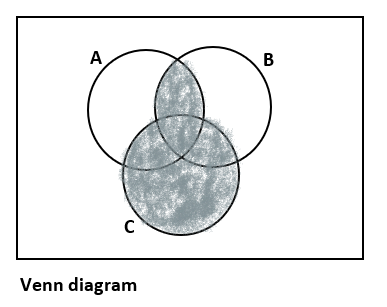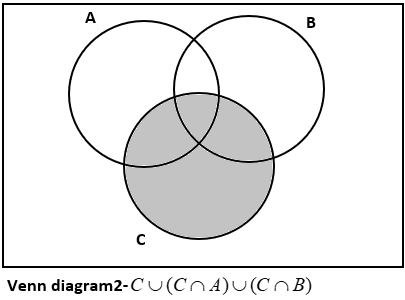
What does the shaded region in the Venn diagram given below represents?

A. \[C\cap ({{A}^{'}}\cap {{B}^{'}})\]
B. \[C\cup ({{C}^{'}}\cap A\cap B)\]
C. \[C\cup (C\cap A)\cup (C\cap B)\]
D. \[C\cup (A/B)\]
Answer
216.3k+ views
Hint: In this question, we are to find the representation of the shaded region in the given Venn diagram. Here we can choose the options by drawing their Venn diagram. This is because a Venn diagram expresses set operations more efficiently. So, we get the required region’s representation by drawing Venn diagrams for each of the given set operations.
Formula Used: Set: A collection of objects in which it is possible to decide whether a given object belongs to the collection or not is said to be a set. Those objects are nothing but the elements in the set.
Sets are represented in two ways: The roaster method and the set builder form
Roaster method:
The set of vowels – \[\left\{ a,\text{ }e,\text{ }i,\text{ }o,\text{ }u \right\}\]
The set of natural numbers – \[\left\{ 1,\text{ }2,\text{ }3,\text{ }\ldots. \right\}\]
Set builder form:
The set of vowels – \[\left\{ x:x\text{ }is\text{ }a\text{ }vowel\text{ }in\text{ }English\text{ }alphabet \right\}\]
The set of natural numbers – \[\left\{ x:x\text{ }is\text{ }a\text{ }natural\text{ }number \right\}\]
Some of the important mathematical sets:
$N$ - the natural number’s set - $N=\{1,2,3...\}$
$Z$- the set of integers - $Z=\{0,\pm 1,\pm 2,\pm 3,...\}$
If two sets $A,B$ where the set $A$ is said to be the subset of $B$ i.e., $A\subseteq B$ then every element of $A$ is in the set $B$ and the set $A$ is said to be the proper subset of $B$ i.e., \[A\subset B\] then $A\subseteq B$ and $A\ne B$.
Complete step by step solution: Given Venn diagram is

From the diagram, we can write
\[C\cup (A\cap C)\cup (B\cap C)\cup (A\cap B)\text{ }...(1)\]
Since we know that \[C\cup (A\cap C)=C\cup (B\cap C)=C;\],
then (1) becomes
\[C\cup (A\cap C)\cup (B\cap C)\cup (A\cap B)=C\cup (A\cap B)\]
Where $A\cap B=(A\cap B)-(A\cap B\cap C)$
So,
\[\begin{align}
& C\cup (A\cap B)=C\cup \left( (A\cap B)-(A\cap B\cap C) \right) \\
& \text{ }=C\cup \left( A\cap B\cap {{C}^{'}} \right) \\
& \text{ }=C\cup \left( {{C}^{'}}\cap B\cap A \right) \\
\end{align}\]
Thus, the shaded region in the above Venn diagram represents \[C\cup ({{C}^{'}}\cap A\cap B)\].
Checking for the other options:
We have the first option as \[C\cap ({{A}^{'}}\cap {{B}^{'}})\]
We can write it as \[C\cap ({{A}^{'}}\cap {{B}^{'}})=C\cap {{(A\cup B)}^{c}}\]
Then, its Venn diagram is

Thus, \[C\cap ({{A}^{'}}\cap {{B}^{'}})\] doesn’t represent the given shaded region.
Similarly, third option we have \[C\cup (C\cap A)\cup (C\cap B)\]
We can write it as
\[\begin{align}
& C\cup (C\cap A)\cup (C\cap B)=\left( C\cup (C\cap A) \right)\cup (C\cap B) \\
& \because C\cup (C\cap A)=C \\
& C\cup (C\cap A)\cup (C\cap B)=C\cup (C\cap B) \\
& \because C\cup (C\cap B)=C \\
& C\cup (C\cap A)\cup (C\cap B)=C \\
\end{align}\]
Its Venn diagram is

Thus, \[C\cup (C\cap A)\cup (C\cap B)\] doesn’t represent the given shaded region.
And \[C\cup (A/B)\] is not possible.
Thus, the second option is the required representation for the given shaded region.
Option ‘B’ is correct
Note: By drawing Venn diagrams for each option given here is an easy method to extract the required set operation for the given shaded region.
Formula Used: Set: A collection of objects in which it is possible to decide whether a given object belongs to the collection or not is said to be a set. Those objects are nothing but the elements in the set.
Sets are represented in two ways: The roaster method and the set builder form
Roaster method:
The set of vowels – \[\left\{ a,\text{ }e,\text{ }i,\text{ }o,\text{ }u \right\}\]
The set of natural numbers – \[\left\{ 1,\text{ }2,\text{ }3,\text{ }\ldots. \right\}\]
Set builder form:
The set of vowels – \[\left\{ x:x\text{ }is\text{ }a\text{ }vowel\text{ }in\text{ }English\text{ }alphabet \right\}\]
The set of natural numbers – \[\left\{ x:x\text{ }is\text{ }a\text{ }natural\text{ }number \right\}\]
Some of the important mathematical sets:
$N$ - the natural number’s set - $N=\{1,2,3...\}$
$Z$- the set of integers - $Z=\{0,\pm 1,\pm 2,\pm 3,...\}$
If two sets $A,B$ where the set $A$ is said to be the subset of $B$ i.e., $A\subseteq B$ then every element of $A$ is in the set $B$ and the set $A$ is said to be the proper subset of $B$ i.e., \[A\subset B\] then $A\subseteq B$ and $A\ne B$.
Complete step by step solution: Given Venn diagram is

From the diagram, we can write
\[C\cup (A\cap C)\cup (B\cap C)\cup (A\cap B)\text{ }...(1)\]
Since we know that \[C\cup (A\cap C)=C\cup (B\cap C)=C;\],
then (1) becomes
\[C\cup (A\cap C)\cup (B\cap C)\cup (A\cap B)=C\cup (A\cap B)\]
Where $A\cap B=(A\cap B)-(A\cap B\cap C)$
So,
\[\begin{align}
& C\cup (A\cap B)=C\cup \left( (A\cap B)-(A\cap B\cap C) \right) \\
& \text{ }=C\cup \left( A\cap B\cap {{C}^{'}} \right) \\
& \text{ }=C\cup \left( {{C}^{'}}\cap B\cap A \right) \\
\end{align}\]
Thus, the shaded region in the above Venn diagram represents \[C\cup ({{C}^{'}}\cap A\cap B)\].
Checking for the other options:
We have the first option as \[C\cap ({{A}^{'}}\cap {{B}^{'}})\]
We can write it as \[C\cap ({{A}^{'}}\cap {{B}^{'}})=C\cap {{(A\cup B)}^{c}}\]
Then, its Venn diagram is

Thus, \[C\cap ({{A}^{'}}\cap {{B}^{'}})\] doesn’t represent the given shaded region.
Similarly, third option we have \[C\cup (C\cap A)\cup (C\cap B)\]
We can write it as
\[\begin{align}
& C\cup (C\cap A)\cup (C\cap B)=\left( C\cup (C\cap A) \right)\cup (C\cap B) \\
& \because C\cup (C\cap A)=C \\
& C\cup (C\cap A)\cup (C\cap B)=C\cup (C\cap B) \\
& \because C\cup (C\cap B)=C \\
& C\cup (C\cap A)\cup (C\cap B)=C \\
\end{align}\]
Its Venn diagram is

Thus, \[C\cup (C\cap A)\cup (C\cap B)\] doesn’t represent the given shaded region.
And \[C\cup (A/B)\] is not possible.
Thus, the second option is the required representation for the given shaded region.
Option ‘B’ is correct
Note: By drawing Venn diagrams for each option given here is an easy method to extract the required set operation for the given shaded region.
Recently Updated Pages
SRMJEEE Result 2024 (Out) Check all the Updates Here

UPESEAT Exam Date 2023

GUJCET Exam Date 2023

TS EAMCET Application form 2023 & Exam Dates

MHT CET Cutoff 2023|Check Previous Year Cut off, Cutoff Trend

TS EAMCET Seat Allotment

Trending doubts
JEE Advanced Marks vs Ranks 2025: Understanding Category-wise Qualifying Marks and Previous Year Cut-offs

Difference Between Exothermic and Endothermic Reactions Explained

Top IIT Colleges in India 2025

IIT Fees Structure 2025

IIT CSE Cutoff: Category‐Wise Opening and Closing Ranks

Understanding the Mechanisms and Key Differences in SN1 and SN2 Reactions

Other Pages
JEE Main 2026: Application Form Open, Exam Dates, Syllabus, Eligibility & Question Papers

Derivation of Equation of Trajectory Explained for Students

NCERT Solutions for Class 11 Maths Chapter 10 Conic Sections

NCERT Solutions for Class 11 Maths Chapter 9 Straight Lines

Hybridisation in Chemistry – Concept, Types & Applications

NCERT Solutions For Class 11 Maths Chapter 8 Sequences And Series




